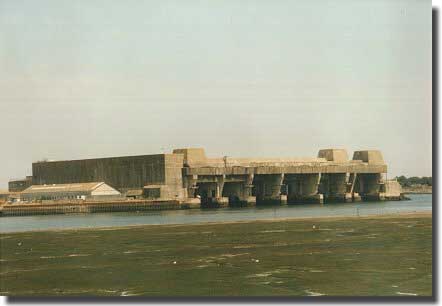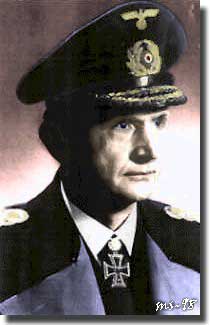|
German Radio called it "Greatest Convoy Battle of all Time." 40 U-Boats carve up Convoys SC122 and HX229. 16-19 March 1943.
Introduction.
U-Boat pens at Lorient France Slow Convoy SC122. The 9th. of March found a feeder convoy consisting of 14 ships ex Halifax joining up, it included the rescue ship Zamelek, making an amazing 18th. voyage in that role. She must have led a charmed life to chug back and forth across the North Atlantic in that unenvious task of dropping back out of the bosom of a convoy to be alone, to stop, and pick up stranded sailors from a torpedoed ship. A sitting duck at that time, once or twice to sail would be bad enough, but to fulfil that role 18 times, pure guts for her Captain and all of her crew. Not withstanding the exits and joining up, this convoy now numbered 50 ships, 5 for Iceland, the remainder destined for the British Isles, all laden with cargoes desperately awaited at their final port. British Escort B-5 joins up.
USS Upshur, part of Convoy SC122 escort Three U-Boat packs sit in wait.
On a North/South line were the two large groups.
Allied intelligence on the 12th. of March read a message from U-621, indicating he had sunk a straggler from Outward Bound North ( slow ) 169, the Baron Kinnard, SC122, was ordered to alter course southward to slip past the waiting Raubgraf wolf pack. This was successful, but the two other groups still lay in the path of SC122, with Sturmer with 18 boats, and south of them Dranger, with their 11 boats. Danger was in the offing! Intelligence blackout from 10th. to 19th. of March 1943. Fast Convoy Halifax229 sailed from New York on the 11th. of March. On the 13th. of March the close escort B-4 joined, 2 ships HMS Highlander, the leader, and the Canadian corvette Sherbrooke were left behind to dry dock.
HMS Highlander, left behind for dry docking when Thus the temporary command of B-4 went to Gordon Luther in the destroyer HMS Volunteer, HMS Witherington, and the very old US 4 stacker Mansfield, the ex 4 stack, but now British HMS Beverley, and finally 2 British corvettes made up a quite woefully thin escort. Convoy HX229A sailed out of New York on the 12th. of March. The duty Escort 40, under John S. Dallison, had 6 warships, 2 new River Class 1,500 ton frigates, Moyola, and Waveney, 2 old sloops each 260 feet long, and a pair of ex American 250 feet Coast Guard Cutters, Lulworth and Landguard, again a pitifully small escort for the job in hand. We now have 3 convoys all eastbound, with SC122 in the van but moving with leaden feet at about 7 knots, on the 15th. of March it ran slap bang into a serious gale, the two smallest ships, the 755 ton Icelandic Selfoss, and the 550 ton ASW trawler Campobello having a hard time of it. Selfoss dropped out of the convoy, but staggered into her destination alone. Campobello had a leak into a coal stowage that could not be plugged, the escort commander sent off the corvette Godetia to collect her crew, and then sink her. One less escort. German U-Boat control orders Raubgraf to speed southwards to intercept SC122 and HX 229. Raubgraf had been in the midst of a frustrating but none too successful encounter with the Outward Bound North 160, they were told to break away, and speed southward for the potentially fine pickings to be had by attacking SC122 and HX229. Commanded by Heinz Walkerling, U-91 found what he thought was SC122 on the 15th. of March, but in fact he had picked up Halifax 229, it was overtaking the plodding SC122. 3 Raubgraf boats, U-84, U-664, and U-758 were ordered by their German Control to close on U-91. U Boat Control homes in 38 boats onto the two convoys. Control now ordered 2 boats coming off a refueling from tanker boats, the remaining 9 from Raubgraf, 11 from Sturmer, and a further 6 from Dranger, and 11 others to speed to the west and close on Feiler. We now have 38 U-boats on their way to join U-653. Carnage looked highly likely. HX 229 under attack. U-603 ( Hans-Joachim Bertelsmann ) sank the 5,200 ton Elin K. Helmut Manseck in U-788, accounted for the 6,800 ton Dutch Zaanland, and damaged the US Liberty James Oglethorpe. U-435 damaged the 7,200 ton US Liberty William Eustis. Bernard Zurmuhlen commanding U-600, sank the British 12,000 ton whale factory ship/tanker Southern Princess and damaged two others, the 8,700 ton British Nariva, plus the 6,100 ton US Irenee Du Pont. The battle continued, Heinz Walkerling in U-91, polished off the 6,400 ton American Harry Luckenbach, and proceeded to have a picnic, picking off the 4 damaged ships, James Ogelthorpe, Nariva, Irenee Du Pont and William Eustis. Still the sinkings went on apace, U-384 sank the British 7,200 ton Coracero, and it finally finished when Jurgen Krugrer in his U-631 sank the Dutch freighter Terkoelei of 5,200 tons. All in all, 10 ships totaling 72,000 tons went to the bottom of the North Atlantic. 7 different U-Boats had enjoyed success. Lack of a rescue ship with HX229. Now it was SC 122's turn to be attacked. Zamelek the Rescue Ship screened by the corvette Saxifrage, dropped back to cope with the mass of survivors. U-Boat Control were confused, they thought the first attack was on SC122, and this one on HX229 , in fact it was the other way round. The Escort Commander, Richard Boyle, asked for reinforcements from Iceland, plus some heavy air cover, the Treasury class Coast Guard Cutter Ingham and the US 4 stack destroyer Babbitt were despatched to help SC122, but when it was realised that HX229 was also in trouble, Babbitt was diverted to that convoy, and in addition the destroyer HMS Vimy was ordered to HX229. The B-4 Escort Commander in Highlander, plus the Canadian corvette Sherbrooke, both delayed when their convoy had sailed, now raced eastwards to reinforce the paltry escort of HX229, it had run into hurricane force winds notably slowing it down.
Convoy under air protection
Coastal Command puts up an umbrella over SC 122, and HX229.
B-24 Very Long Range Aircraft used HX229 again in trouble. U-527's Herbert Uhlig gained two hits on the American Mathew Luckenbach, she was abandoned, and the crew rescued from their lifeboats by both Ingham and Upshur. U-527 returned to finish her off, but his compatriot Walter Piezsch in U-523 arrived first, and set off one torpedo to finish the job, and Mathew Luckenbach made for the ocean floor. March 18. But 5 aircraft, also from Squadron 120 provided cover for 10 hours over SC122, they attacked U-boats 4 times, but alas to no avail. March 19.
Coastal Command Sunderland aircraft, part of the air umbrella The U-boats that attacked HX229, achieved 13 sinkings to total 93,502 tons, and 10 boats had all sunk ships, it was the best after the infamous Convoy PQ17 in the tonnage sunk stakes. Only one U-boat pays the price. The Berlin propagandists have a field day. But if looked at from a two separate battle event, attacked in the main, by three diverse U-Boat groups, Raubgraf, Sturmer and Dranger, the final results were not a record. SC122 lost 9 ships, and HX229 13 vessels, all up, 146,500 tons, and 40 boats committed. This result, a little over .5 of a ship sunk per U-Boat involved, was about average , none the less, the Allies could ill afford to see these ships go under the grey North Atlantic surface. Conclusion.
Admiral Karl Donitz, head of the U-Boat arm The whole scenario was only saved from being a total disaster by the fact that surface reinforcements came in from Iceland, but more importantly, the air umbrella flown by VLR B-24's, B-17's and Sunderlands found many of the attacking U-Boats and forced them to keep their heads down, and a real plus for the aircraft, U-384 was sunk. In all, 54 sorties were flown over the two convoys, the aircraft reporting sighting 32 boats, and attacking them 21 times, a busy time for all the airmen involved. The 10 days when the Code breakers were bereft of the U-Boat signal traffic had proved very costly, 22 ships sunk, crewmen dying, and their precious cargoes destroyed. By the 20th. of March 1943, all the U-Boat traffic was again being read. These two convoys indicated the necessity of strong ship escorts, and of heavy air cover. But in only two more months the Allies were on top of the U-Boat menace on the Atlantic run, and in May of 1943, The Battle of the Atlantic was finally won. |







